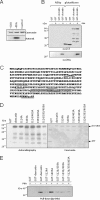Dematin, a component of the erythrocyte membrane skeleton, is internalized by the malaria parasite and associates with Plasmodium 14-3-3
- PMID: 21084299
- PMCID: PMC3020730
- DOI: 10.1074/jbc.M110.194613
Dematin, a component of the erythrocyte membrane skeleton, is internalized by the malaria parasite and associates with Plasmodium 14-3-3
Abstract
The malaria parasite invades the terminally differentiated erythrocytes, where it grows and multiplies surrounded by a parasitophorous vacuole. Plasmodium blood stages translocate newly synthesized proteins outside the parasitophorous vacuole and direct them to various erythrocyte compartments, including the cytoskeleton and the plasma membrane. Here, we show that the remodeling of the host cell directed by the parasite also includes the recruitment of dematin, an actin-binding protein of the erythrocyte membrane skeleton and its repositioning to the parasite. Internalized dematin was found associated with Plasmodium 14-3-3, which belongs to a family of conserved multitask molecules. We also show that, in vitro, the dematin-14-3-3 interaction is strictly dependent on phosphorylation of dematin at Ser(124) and Ser(333), belonging to two 14-3-3 putative binding motifs. This study is the first report showing that a component of the erythrocyte spectrin-based membrane skeleton is recruited by the malaria parasite following erythrocyte infection.
Figures





Similar articles
-
Headpiece domain of dematin is required for the stability of the erythrocyte membrane.Proc Natl Acad Sci U S A. 2002 May 14;99(10):6637-42. doi: 10.1073/pnas.052155999. Proc Natl Acad Sci U S A. 2002. PMID: 12011427 Free PMC article.
-
Combined deletion of mouse dematin-headpiece and beta-adducin exerts a novel effect on the spectrin-actin junctions leading to erythrocyte fragility and hemolytic anemia.J Biol Chem. 2007 Feb 9;282(6):4124-35. doi: 10.1074/jbc.M610231200. Epub 2006 Dec 2. J Biol Chem. 2007. PMID: 17142833
-
Evidence for a role for a Plasmodium falciparum homologue of Sec31p in the export of proteins to the surface of malaria parasite-infected erythrocytes.J Cell Sci. 2001 Sep;114(Pt 18):3377-86. doi: 10.1242/jcs.114.18.3377. J Cell Sci. 2001. PMID: 11591825
-
Vesicle-mediated trafficking of parasite proteins to the host cell cytosol and erythrocyte surface membrane in Plasmodium falciparum infected erythrocytes.Int J Parasitol. 2001 Oct;31(12):1381-91. doi: 10.1016/s0020-7519(01)00256-9. Int J Parasitol. 2001. PMID: 11566305 Review.
-
Cytoskeletal and membrane remodelling during malaria parasite invasion of the human erythrocyte.Br J Haematol. 2011 Sep;154(6):680-9. doi: 10.1111/j.1365-2141.2011.08766.x. Epub 2011 Jul 1. Br J Haematol. 2011. PMID: 21718279 Review.
Cited by
-
Sequential Membrane Rupture and Vesiculation during Plasmodium berghei Gametocyte Egress from the Red Blood Cell.Sci Rep. 2018 Feb 23;8(1):3543. doi: 10.1038/s41598-018-21801-3. Sci Rep. 2018. PMID: 29476099 Free PMC article.
-
Exploring the Plasmodium falciparum cyclic-adenosine monophosphate (cAMP)-dependent protein kinase (PfPKA) as a therapeutic target.Microbes Infect. 2012 Aug;14(10):838-50. doi: 10.1016/j.micinf.2012.05.004. Epub 2012 May 22. Microbes Infect. 2012. PMID: 22626931 Free PMC article. Review.
-
The Plasmodium berghei serine protease PbSUB1 plays an important role in male gamete egress.Cell Microbiol. 2019 Jul;21(7):e13028. doi: 10.1111/cmi.13028. Epub 2019 Apr 29. Cell Microbiol. 2019. PMID: 30941868 Free PMC article.
-
Hypermethylation of DMTN promotes the metastasis of colorectal cancer cells by regulating the actin cytoskeleton through Rac1 signaling activation.J Exp Clin Cancer Res. 2018 Dec 4;37(1):299. doi: 10.1186/s13046-018-0958-1. J Exp Clin Cancer Res. 2018. PMID: 30514346 Free PMC article.
-
Protective immunity induced by Eimeria common antigen 14-3-3 against Eimeria tenella, Eimeria acervulina and Eimeria maxima.BMC Vet Res. 2018 Nov 12;14(1):337. doi: 10.1186/s12917-018-1665-z. BMC Vet Res. 2018. PMID: 30419898 Free PMC article.
References
-
- Marti M., Good R. T., Rug M., Knuepfer E., Cowman A. F. (2004) Science 306, 1930–1933 - PubMed
-
- Hiller N. L., Bhattacharjee S., van Ooij C., Liolios K., Harrison T., Lopez-Estraño C., Haldar K. (2004) Science 306, 1934–1937 - PubMed
-
- Maier A. G., Cooke B. M., Cowman A. F., Tilley L. (2009) Nat. Rev. Microbiol. 7, 341–354 - PubMed
-
- Azim A. C., Knoll J. H., Beggs A. H., Chishti A. H. (1995) J. Biol. Chem. 270, 17407–17413 - PubMed
-
- Bruce L. J., Beckmann R., Ribeiro M. L., Peters L. L., Chasis J. A., Delaunay J., Mohandas N., Anstee D. J., Tanner M. J. (2003) Blood 101, 4180–4188 - PubMed
Publication types
MeSH terms
Substances
LinkOut - more resources
Full Text Sources
Medical
Molecular Biology Databases

